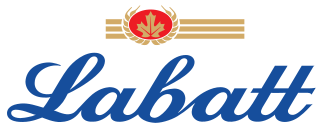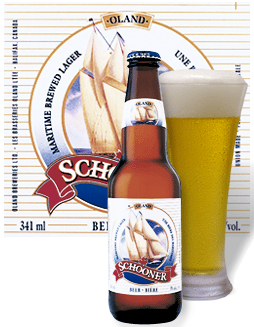Related Research Articles

Advertising is the practice and techniques employed to bring attention to a product or service. Advertising aims to put a product or service in the spotlight in hopes of drawing it attention from consumers. It is typically used to promote a specific good or service, but there are wide range of uses, the most common being the commercial advertisement.

An alcopop is any of certain mixed alcoholic beverages with relatively low alcohol content, including:
- Malt beverages to which various fruit juices or other flavorings have been added
- Wine coolers: beverages containing wine to which ingredients such as fruit juice or other flavorings have been added
- Mixed drinks containing distilled alcohol and sweet liquids such as fruit juices or other flavourings
Ice beer is a beer that has undergone some degree of freezing during production. These beers generally have a higher alcohol content, and lower price relative to it.

Labatt Brewing Company Limited is a Belgian-owned brewery headquartered in Toronto, Ontario, Canada. Founded in 1847, Labatt is the largest brewer in Canada.
Film promotion is the practice of promotion specifically in the film industry, and usually occurs in coordination with the process of film distribution. Sometimes called the press junket or film junket, film promotion generally includes press releases, advertising campaigns, merchandising, franchising, media and interviews with the key people involved with the making of the film, like actors and directors. As with all business, it is an important part of any release because of the inherent high financial risk; film studios will invest in expensive marketing campaigns to maximize revenue early in the release cycle. Marketing budgets tend to equal about half the production budget. Publicity is generally handled by the distributor and exhibitors.

Product placement, also known as embedded marketing, is a marketing technique where references to specific brands or products are incorporated into another work, such as a film or television program, with specific promotional intent. Much of this is done by loaning products, especially when expensive items, such as vehicles, are involved. In 2021, the agreements between brand owners and films and television programs were worth more than US$20 billion.
Advertising in video games is the integration of advertising into video games to promote products, organizations, or viewpoints.

Beer was introduced to Canada by European settlers in the seventeenth century. The first commercial brewery was La Brasseries du Roy started by New France Intendant Jean Talon, in Québec City in 1668. Many commercial brewers thrived until prohibition in Canada. The provincial and federal governments' attempt to eliminate "intoxicating" beverages led to the closing of nearly three quarters of breweries between 1878 and 1928. It was only in the second half of the twentieth century that a significant number of new breweries opened up. The Canadian beer industry now plays an important role in Canadian identity, although globalization of the brewing industry has seen the major players in Canada acquired by or merged with foreign companies, notably its three largest beer producers: Labatt, Molson and Sleeman. The result is that Moosehead, with an estimated 3.8 percent share of the domestic market in 2016, has become the largest fully Canadian-owned brewer.

Kokanee is a beer brewed at the Columbia Brewery in Creston, British Columbia. Columbia Brewery began brewing Kokanee lager in 1959 and was purchased by the Labatt Brewing Company in 1974.

Lucky Lager is an American lager with U.S. brewing and distribution rights held by the Pabst Brewing Company. Originally launched in 1934 by the San Francisco-based General Brewing Company, Lucky Lager grew to be one of the prominent beers of the Western United States during the 1950s and 1960s. In 2019, Pabst announced that the beer brand would be revived and would be brewed by 21st Amendment Brewery, a brewery based in San Leandro.
The Lakeport Brewing Company was a brewery located in Hamilton, Ontario, Canada. Although it started as a producer of premium beers, it later switched to cheap discount brands, using a strategy of selling its beer for "a buck a bottle". By 2006, it had become the largest discount brewer in Canada. In 2007, Lakeport was taken over by InBev's Canadian subsidiary, Labatt. Three years later, InBev closed the Hamilton brewing plant, and shifted production of Lakeport beers to the Labatt plant in London, Ontario.
In marketing, branded content is content produced by an advertiser or content whose creation was funded by an advertiser. In contrast to content marketing and product placement, branded content is designed to build awareness for a brand by associating it with content that shares its values. The content does not necessarily need to be a promotion for the brand, although it may still include product placement.
A mobile campaign is a campaign, usually marketing, advertising, or public relations-related, through which organizations contact their audience through SMS. This form of campaigning allows organizations to reach out and establish relationships with an audience in a more individualized, intimate way. The foundational function of mobile campaigns is regularly referred to as mobile marketing. A campaign's goal can have varied consumer consumption objectives including flashing, informing or engaging. Mobile campaigns have developed from the periphery of advertising to being an integral part of an effective marketing strategy. Online advertising is the second largest advertising spend at $113 billion, next to television's $196.5 billion. Near the introduction of mobile campaigns, they were primarily created to boost the impact of primary campaigns. A good example of one of the first mobile campaigns is the viewer voting system employed in American Idol. Using the American Idol example, the primary campaign was television, and the engagement was mobile, “watch this show, and text to vote”. In 2012, there were over 131 million votes in a single night, setting the world mobile voting record. With over 90% of Americans having cell phones, and there being over 6.8 billion cell phones in circulation globally versus 2.4 billion with internet access, mobile campaigns are evolving to be the way of the future in advertising and consumer engagement.

Digital marketing is the component of marketing that uses the Internet and online based digital technologies such as desktop computers, mobile phones and other digital media and platforms to promote products and services. Its development during the 1990s and 2000s changed the way brands and businesses use technology for marketing. As digital platforms became increasingly incorporated into marketing plans and everyday life, and as people increasingly use digital devices instead of visiting physical shops, digital marketing campaigns have become prevalent, employing combinations of search engine optimization (SEO), search engine marketing (SEM), content marketing, influencer marketing, content automation, campaign marketing, data-driven marketing, e-commerce marketing, social media marketing, social media optimization, e-mail direct marketing, display advertising, e–books, and optical disks and games have become commonplace. Digital marketing extends to non-Internet channels that provide digital media, such as television, mobile phones, callback, and on-hold mobile ring tones. The extension to non-Internet channels differentiates digital marketing from online marketing.

Schooner is a regional lager style beer of the eastern Canadian provinces. It has an alcohol content of 5.0% ABV and is brewed at the Oland Brewery in Halifax, Nova Scotia.
Social network advertising, also social media targeting, is a group of terms that are used to describe forms of online advertising/digital marketing that focus on social networking services. One of the major benefits of this type of advertising is that advertisers can take advantage of the users' demographic information and target their ads appropriately.

Social media marketing is the use of social media platforms and websites to promote a product or service. Although the terms e-marketing and digital marketing are still dominant in academia, social media marketing is becoming more popular for both practitioners and researchers. Most social media platforms have built-in data analytics tools, enabling companies to track the progress, success, and engagement of ad campaigns. Companies address a range of stakeholders through social media marketing, including current and potential customers, current and potential employees, journalists, bloggers, and the general public. On a strategic level, social media marketing includes the management of a marketing campaign, governance, setting the scope and the establishment of a firm's desired social media "culture" and "tone."
FIFCO USA is an American brewing company based in Rochester, New York.

American lager or North American lager is pale lager that is produced in the United States. The pale lager-style beer originated in Europe in the mid-19th century, and moved to the US with German immigrants. As a general trend outside of Bavaria and the Czech Republic where the beers may be firmly hopped, pale lager developed as a modestly hopped beer, and sometimes used adjuncts such as rice or corn – and this was also true in the US.
Native advertising, also called sponsored content, is a type of advertising that matches the form and function of the platform upon which it appears. In many cases it functions like an advertorial, and manifests as a video, article or editorial. The word native refers to this coherence of the content with the other media that appear on the platform.
References
- 1 2 3 4 5 6 7 "Labatt rolls out a Kokanee ad in the shape of a feature-length movie". Toronto: The Globe & Mail. 27 February 2013. Retrieved 28 February 2013.
- ↑ "Kokanee restarts its Ranger advertising". Marketing Magazine. Retrieved 17 March 2013.
- ↑ "After six years, Kokanee kills the Ranger". Marketing Magazine. Retrieved 17 March 2013.
- 1 2 3 4 "Labatt takes product placement to the extreme with Kokane movie". The Toronto Star. 28 February 2013. Retrieved 28 February 2013.
- 1 2 3 4 "A Big-Screen Brand-Content Play: Behind Kokanee's Cinematic Debut, "The Movie Out Here"". Co.Create. Retrieved 17 March 2013.
- 1 2 3 "Alliance Films sets pic promoting beer". Variety. Retrieved 27 February 2013.
- 1 2 3 4 5 "The Movie Out Here rewrites rules of product placement". Movie Guide. Canada.com. Retrieved 24 February 2013.
- ↑ "Whistler unveils 2012 slate". Variety. Retrieved 24 February 2013.
- ↑ "The Movie Out Here is an abomination". Straight.com. 4 March 2013. Retrieved 5 March 2013.
- ↑ Katherine, Monk. "Review: Extended beer commercial The Movie Out Here will drive you to drink". Calgary Herald. Postmedia News. Retrieved 2 March 2013.